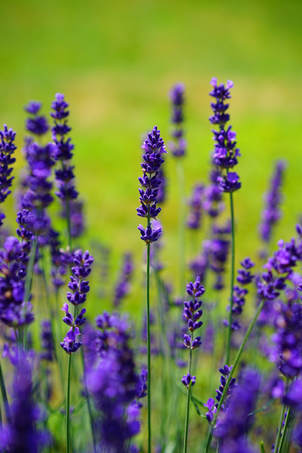
Lavandula is a genus of about 32 species (groups of plants with similar characteristics). There are some varieties which are a cross between two species. As well as the familiar classic lavender pale blue colour, they are also available in all shades of blue, purple, pink and even green or white flowers.
Lavenders come from all over the world but mostly from the Northern Hemisphere. They occur in places with hot dry summers. They are not native to the UK and there is no consensus as to when they first arrived in the UK. Some sources say that they were brought here by the Romans but other sources state that they didn’t arrive here until the 1500’s.
The 3 main species that you will find on sale in the UK are:
Lavenders come from all over the world but mostly from the Northern Hemisphere. They occur in places with hot dry summers. They are not native to the UK and there is no consensus as to when they first arrived in the UK. Some sources say that they were brought here by the Romans but other sources state that they didn’t arrive here until the 1500’s.
The 3 main species that you will find on sale in the UK are:
- Lavandula angustifolia - the smallest and smelliest
- Lavandula intermedia - often called Old English
- Lavandula stoechas - often called French Lavender
History
The word Lavender comes from the Latin verb Lavare which means to wash, hence lavenders long connection with people's hygiene. The Egyptians used lavender flowers mixed with sand as an exfoliant. The Romans used Lavender as a strewing herb for its deodorising and antiseptic properties.
In Elizabethan times when the fashion was for masking bodily odours rather than for bathing, Lavender was said to be Elizabeth the first’s favorite perfume. Lavender was finally added to soap around 1671 when Charles the first sold his monopoly on soap making to a young merchant called William Yardley who quickly realised the value of lavender soap and planted lavender fields at Mitcham in Surrey.
In Elizabethan times when the fashion was for masking bodily odours rather than for bathing, Lavender was said to be Elizabeth the first’s favorite perfume. Lavender was finally added to soap around 1671 when Charles the first sold his monopoly on soap making to a young merchant called William Yardley who quickly realised the value of lavender soap and planted lavender fields at Mitcham in Surrey.
Growing Lavender
What soil do they like?
Lavenders prefer a neutral to alkaline soil, although stoechas varieties will grow on slightly acid soil. They all like a well drained soil. For this reason they are an ideal patio pot plant.
What conditions do they like?
They all like hot dry positions with as much sun as possible.
How do I prune lavenders?
Pruning is the key to healthy Lavenders. Prune back hard (down to 20cms) in the last week of August . Give a small dressing of potash and a handful of lime per sq. metre every spring.
Which ones are easiest to grow?
If you struggle to grow lavenders, try the intermedia species (sometimes referred to as Old English). They put up with unsuitable conditions better than most other types. For a really spectacular spring, summer and autumn display try growing some Lavandula stoechas " Devonshire Compact " in a pot on the patio.
Lavenders prefer a neutral to alkaline soil, although stoechas varieties will grow on slightly acid soil. They all like a well drained soil. For this reason they are an ideal patio pot plant.
What conditions do they like?
They all like hot dry positions with as much sun as possible.
How do I prune lavenders?
Pruning is the key to healthy Lavenders. Prune back hard (down to 20cms) in the last week of August . Give a small dressing of potash and a handful of lime per sq. metre every spring.
Which ones are easiest to grow?
If you struggle to grow lavenders, try the intermedia species (sometimes referred to as Old English). They put up with unsuitable conditions better than most other types. For a really spectacular spring, summer and autumn display try growing some Lavandula stoechas " Devonshire Compact " in a pot on the patio.

